1 背景
由于股票撮合中,我们使用zset构建到价成交,故这里对rangebyscore命令进行原位压力测试
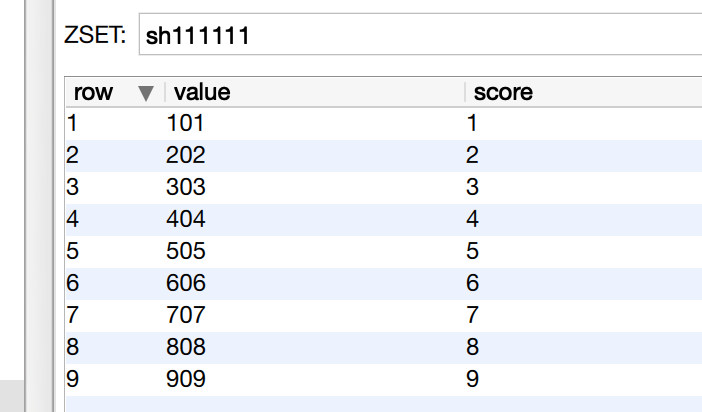
redis线程池如何定,为什么开10个disruptor消费线程(redis连接):
1)io密集型4核2(n+1);
2)从第2点本地压测结果看,10线程已80%满足最高qps;
3)disruptor太多线程不好
2 首先压一波本地
压测设备:mac 2016 12'
2.1 docker
redis-benchmark -h 127.0.0.1 -p 63790 -c 100 -n 10000 script load "redis.call('zrangebyscore','sh111111','3','9')"
| java benchmark | java 代码 | redis命令行 | |
| 1 | 807 | 729 | 866 |
| 10 | 3115 | 3115 | 3187 |
| 50 | 4467 | 4235 | 4640 |
| 100 | 4375 | 4417 | 5238 |
| 500 | 5747 |
*java benchmark与java代码都存在从池拿连接的操作
2.2 native
redis-benchmark -h 127.0.0.1 -p 6379 -c 1 -n 10000 script load "redis.call('zrangebyscore','sh111111','3','9')"
| java benchmark | java 代码 | redis命令行 | |
| 1 | 11729 | 6050 | 10131 |
| 10 | 28597 | 18653 | 21000 |
| 50 | 31943 | 29056 | 23584 |
| 100 | 29476 | 28438 | 24875 |
| 500 | 24937 |
那么我们看到局域网及docker的测试,可能经过网卡后,10线程qps为3k,这个值与官方宣称的10w相去甚远,所以我看下往上其它人的压测结果
3 其它参考:
3.1 openresty-redis在不同网络环境下QPS对比讲解
http://blog.sina.cn/dpool/blog/s/blog_6145ed810102vefe.html?from=groupmessage&isappinstalled=0
redis相对openresty网络环境redis(requests per second)openresty(requests per second)
本地52631.58
局域网3105.59 与我docker测试水平相当
公网(纽约节点)169.95
3.2 memcache、redis、tair性能对比测试报告
http://blog.sina.cn/dpool/blog/s/blog_6145ed810102vefe.html?from=groupmessage&isappinstalled=0
以单线程通过各缓存客户端get调用向服务端获取数据,比较10000操作所消耗的时间
redis 1k对象 1260qps
并发1000个线程通过缓存软件的客户get调用向服务端获取数据,每个线程完成10000次的操作
redis 1k对象 11430qps 这个数据比我测试的要大三倍
4 阿里云redis qps 10线程,4.7万qps
https://zhuanlan.zhihu.com/p/78034665?utm_source=wechat_session&utm_medium=social&utm_oi=1003056052560101376&from=singlemessage&isappinstalled=0&wechatShare=1&s_s_i=Nxnfuuur16PoKq5S8w%2Bv7CqmqZ5fwF2fxQZXH9O4%2FPM%3D&s_r=1
阿里云社区版
社区 标准版双副本 1g主从 redis5.0 号称8w qps(集群256分片2560w qps),企业版24w(集群6144w):https://help.aliyun.com/document_detail/26350.html
施压机 :4 vCPU 8 GiB (I/O优化)ecs.c6.xlarge 10Mbps (峰值)

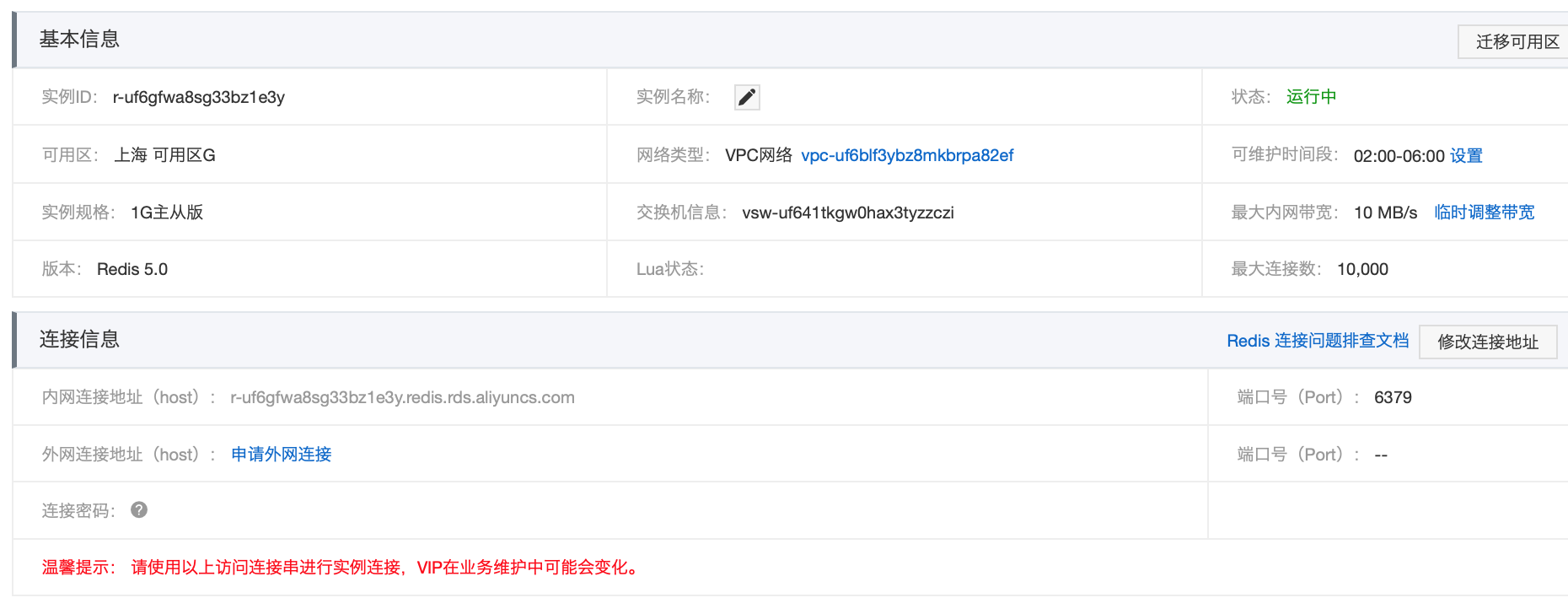
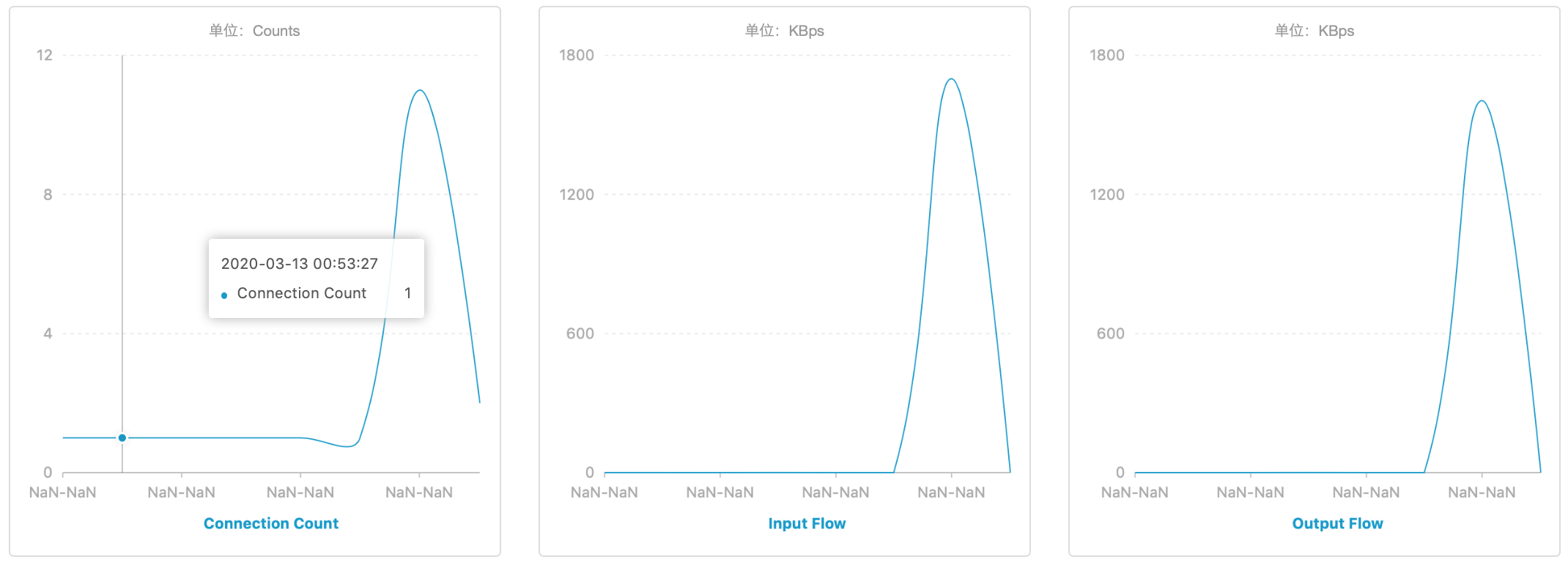

5 后话,为什么redis 多线程客户端获得更大qps,大到什么程度
以一个例子说明,假设:
一次命令时间(borrow|return resource + Jedis执行命令(含网络) )的平均耗时约为1ms,一个连接的QPS大约是1000 业务期望的QPS是50000 那么理论上需要的资源池大小是50000 / 1000 = 50个。但事实上这是个理论值,还要考虑到要比理论值预留一些资源,通常来讲maxTotal可以比理论值大一些。
但这个值不是越大越好,一方面连接太多占用客户端和服务端资源,另一方面对于Redis这种高QPS的服务器,一个大命令的阻塞即使设置再大资源池仍然会无济于事。
https://cloud.tencent.com/developer/article/1425158
注意,redis多线程qps并不像理论的那样,多个线程qps=单个线程*线程数(有点像负载均衡),因为线程之间相互切换吞吐量相互制约,成非线性关系
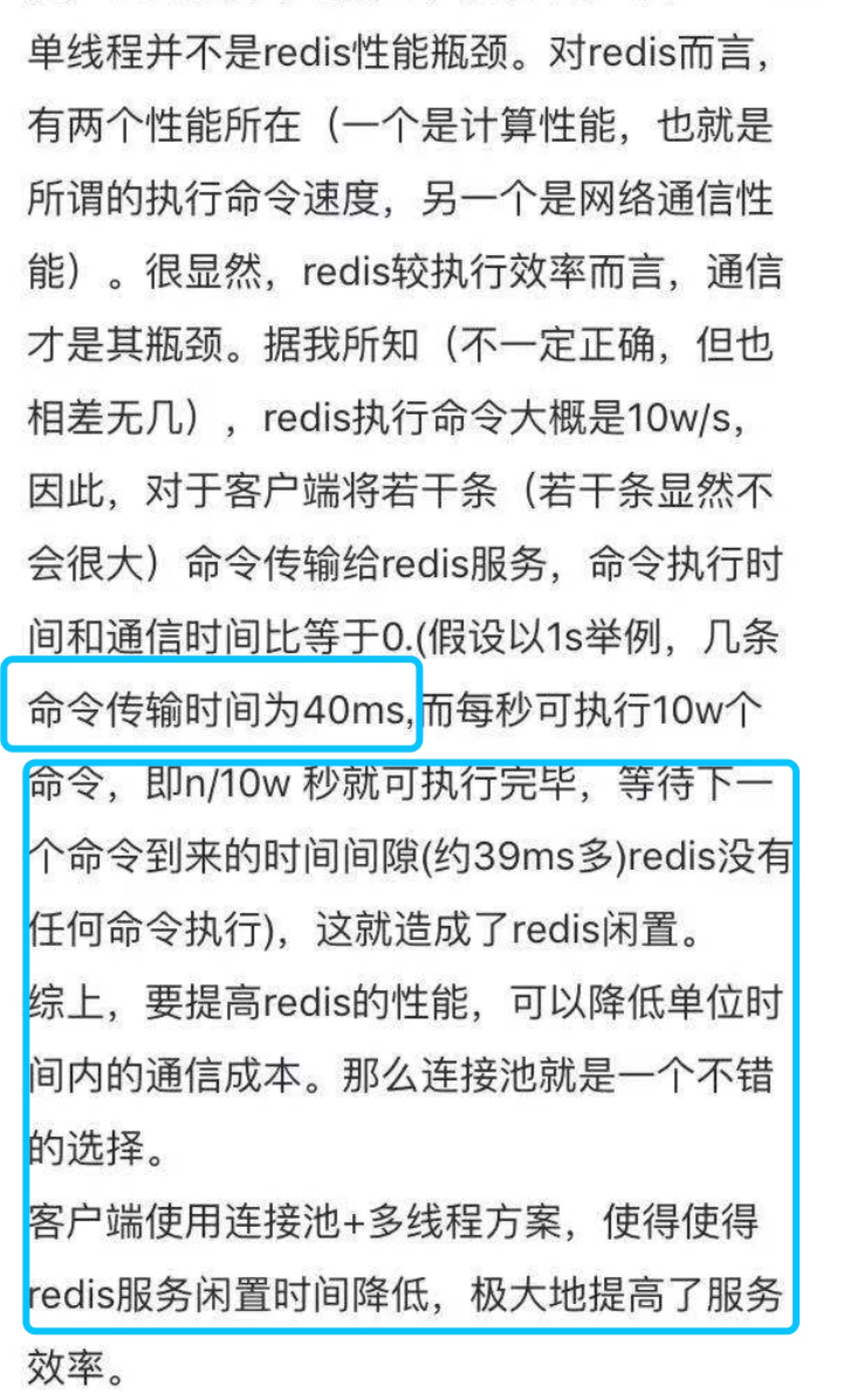
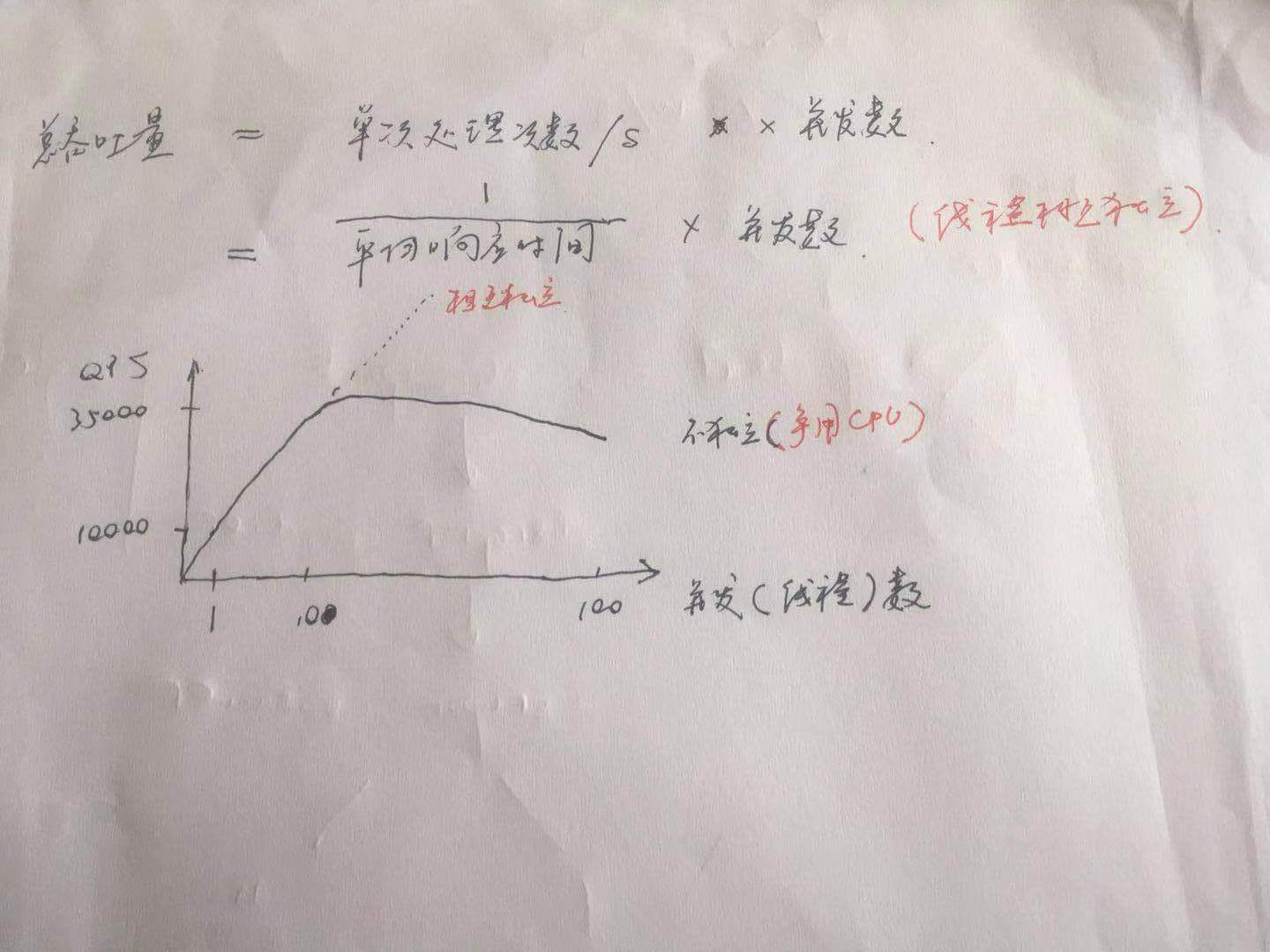
6 性能监控:
参考1 https://www.cnblogs.com/cheyunhua/p/9068029.html 设置redis最大内存,类似于java内存的xmx
参考2 https://blog.csdn.net/z644041867/article/details/77965521 性能监控指标
redis-cli info | grep -w "connected_clients" |awk -F':' '{print $2}'
redis-cli info | grep -w "used_memory_rss_human" |awk -F':' '{print $2}' 类似于java内存jmx监控的commited和used
redis-cli info | grep -w "used_memory_peak_human" |awk -F':' '{print $2}'
redis-cli info | grep -w "instantaneous_ops_per_sec" |awk -F':' '{print $2}'
redis-benchmark -h 127.0.0.1 -p 6379 -c 1 -n 1000000 script load "redis.call('zrangebyscore','sh111111','3','9')"
^Cript load redis.call('zrangebyscore','sh111111','3','9'): 10026.05
JoycedeMacBook:redis-5.0.5 joyce$ redis-cli info | grep -w "instantaneous_ops_per_sec" |awk -F':' '{print $2}'
0
JoycedeMacBook:redis-5.0.5 joyce$ redis-cli info | grep -w "instantaneous_ops_per_sec" |awk -F':' '{print $2}'
9666
JoycedeMacBook:redis-5.0.5 joyce$ redis-cli info | grep -w "instantaneous_ops_per_sec" |awk -F':' '{print $2}'
9473
JoycedeMacBook:redis-5.0.5 joyce$ redis-cli info | grep -w "instantaneous_ops_per_sec" |awk -F':' '{print $2}'
10249
JoycedeMacBook:redis-5.0.5 joyce$ redis-cli info | grep -w "instantaneous_ops_per_sec" |awk -F':' '{print $2}'
10590
JoycedeMacBook:redis-5.0.5 joyce$ redis-cli info | grep -w "instantaneous_ops_per_sec" |awk -F':' '{print $2}'
10486
JoycedeMacBook:redis-5.0.5 joyce$ redis-cli info | grep -w "instantaneous_ops_per_sec" |awk -F':' '{print $2}'
10421
JoycedeMacBook:redis-5.0.5 joyce$ redis-cli info | grep -w "instantaneous_ops_per_sec" |awk -F':' '{print $2}'
10450
JoycedeMacBook:redis-5.0.5 joyce$ redis-cli info | grep -w "instantaneous_ops_per_sec" |awk -F':' '{print $2}'
10673
JoycedeMacBook:redis-5.0.5 joyce$ redis-cli info | grep -w "instantaneous_ops_per_sec" |awk -F':' '{print $2}'
10707
JoycedeMacBook:redis-5.0.5 joyce$ redis-cli info | grep -w "instantaneous_ops_per_sec" |awk -F':' '{print $2}'
10655
JoycedeMacBook:redis-5.0.5 joyce$ redis-cli info | grep -w "instantaneous_ops_per_sec" |awk -F':' '{print $2}'
10530
JoycedeMacBook:redis-5.0.5 joyce$ redis-cli info | grep -w "instantaneous_ops_per_sec" |awk -F':' '{print $2}'
10570
JoycedeMacBook:redis-5.0.5 joyce$ redis-cli info | grep -w "instantaneous_ops_per_sec" |awk -F':' '{print $2}'
10396
JoycedeMacBook:redis-5.0.5 joyce$ redis-cli info | grep -w "instantaneous_ops_per_sec" |awk -F':' '{print $2}'
9595
JoycedeMacBook:redis-5.0.5 joyce$ redis-cli info | grep -w "instantaneous_ops_per_sec" |awk -F':' '{print $2}'
9010
JoycedeMacBook:redis-5.0.5 joyce$ redis-cli info | grep -w "instantaneous_ops_per_sec" |awk -F':' '{print $2}'
9414
7 测试代码:
package redis;
import com.alibaba.fastjson.JSON;
import com.alibaba.fastjson.JSONObject;
import com.google.protobuf.InvalidProtocolBufferException;
import ip.IpPool;
import org.apache.commons.pool2.impl.GenericObjectPool;
import org.apache.commons.pool2.impl.GenericObjectPoolConfig;
import org.openjdk.jmh.annotations.*;
import org.openjdk.jmh.runner.Runner;
import org.openjdk.jmh.runner.RunnerException;
import org.openjdk.jmh.runner.options.Options;
import org.openjdk.jmh.runner.options.OptionsBuilder;
import org.redisson.Redisson;
import org.redisson.api.RBucket;
import org.redisson.api.RedissonClient;
import org.redisson.config.Config;
import redis.clients.jedis.Jedis;
import redis.clients.jedis.JedisPool;
import redis.clients.jedis.JedisPoolConfig;
import serial.MyBaseBean;
import serial.MyBaseProto;
import java.util.Set;
import java.util.concurrent.CountDownLatch;
import java.util.concurrent.TimeUnit;
/**
* Created by joyce on 2019/10/24.
*/
@BenchmarkMode(Mode.Throughput)//基准测试类型
@OutputTimeUnit(TimeUnit.SECONDS)//基准测试结果的时间类型
@Threads(10)//测试线程数量(IO密集)
@State(Scope.Thread)//该状态为每个线程独享
public class YaliRedis {
private static JedisPool jedisPool;
private static final int threadCount = 10;
@Setup
public static void init() {
JedisPoolConfig config = new JedisPoolConfig();
config.setMaxTotal(800);
config.setMaxIdle(800);
jedisPool = new JedisPool(config,"localhost",63790,2000,"test");
// Jedis jedis = jedisPool.getResource();
// String test = jedis.get("testkey");
// System.out.println(test);
// Set<String> set = jedis.zrangeByScore("sh111111", 3,9);
// System.out.println(set.size());
// jedis.close();
}
@TearDown
public static void destroy() {
jedisPool.close();
}
public static void main(String[] args) throws Exception {
// initData();
if(false) {
Options opt = new OptionsBuilder().include(YaliRedis.class.getSimpleName()).forks(1).warmupIterations(1)
.measurementIterations(3).build();
new Runner(opt).run();
} else {
init();
final int perThread = 10000;
CountDownLatch countDownLatchMain = new CountDownLatch(threadCount);
CountDownLatch countDownLatchSub = new CountDownLatch(1);
for(int i=0; i<threadCount; ++i) {
new Thread(new Runnable() {
@Override
public void run() {
try {
countDownLatchSub.await();
Set<String> set = null;
for(int j=0; j<perThread; ++j)
set = testZSet();
System.out.println(set.size());
} catch (Exception e) {
e.printStackTrace();
} finally {
countDownLatchMain.countDown();
}
}
}).start();
}
long st = (System.currentTimeMillis());
countDownLatchSub.countDown();
countDownLatchMain.await();
System.out.println(System.currentTimeMillis() - st);
System.out.println(threadCount * perThread * 1000 / (System.currentTimeMillis() - st));
}
}
@Benchmark
public static Set<String> testZSet() {
Jedis jedis = null;
jedis = jedisPool.getResource();
Set<String> set = jedis.zrangeByScore("sh111111", 3,9);
jedis.close();
return set;
}
// @Benchmark
public static void test() {
Jedis jedis = null;
jedis = jedisPool.getResource();
jedis.get("testkey");
jedis.close();
}
// @Benchmark
public static void testJson() {
Jedis jedis = null;
jedis = jedisPool.getResource();
String xx = jedis.get("testjson");
JSONObject userJson = JSONObject.parseObject(xx);
MyBaseBean user = JSON.toJavaObject(userJson,MyBaseBean.class);
jedis.close();
}
// @Benchmark
public static void testPb() {
Jedis jedis = null;
jedis = jedisPool.getResource();
byte [] bytes = jedis.get("testpb".getBytes());
try {
MyBaseProto.BaseProto baseProto = MyBaseProto.BaseProto.parseFrom(bytes);
} catch (InvalidProtocolBufferException e) {
e.printStackTrace();
}
jedis.close();
}
public static void initData() {
Jedis jedis = new Jedis("localhost", 63790);
jedis.auth("test");
for(int i=1; i<=9; ++i) {
jedis.zadd("sh111111", i, String.valueOf(i*100));
}
}
}
8 备用:
1 redis-benchmark. + ( java bench jedis )
1)redis 本机
redis-benchmark -h 127.0.0.1 -p 6379 -c 1000 -n 10000 script load "redis.call('zrangebyscore','sh111111','3','9)"
1 th
10000 (11500)
50 th
24000 (33000)
100 th
25000 (30000)
500 th
26000 (20000)
1000 th
24000
2)docker
redis-benchmark -h 127.0.0.1 -p 63790 -c 100 -n 10000 script load "redis.call('zrangebyscore','sh111111','3','9)"
1 th
640 (700)
50 th
3900 (3300)
100 th
4400 (3800)
500 th
6000 (4500). 约80%
1000 th
5300